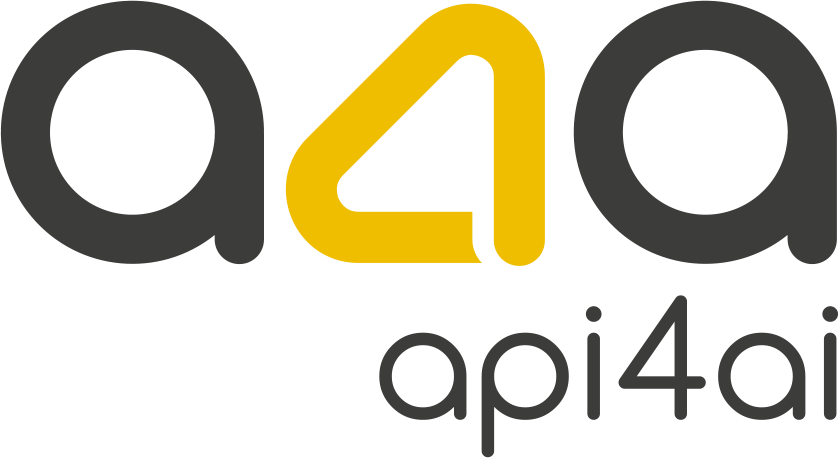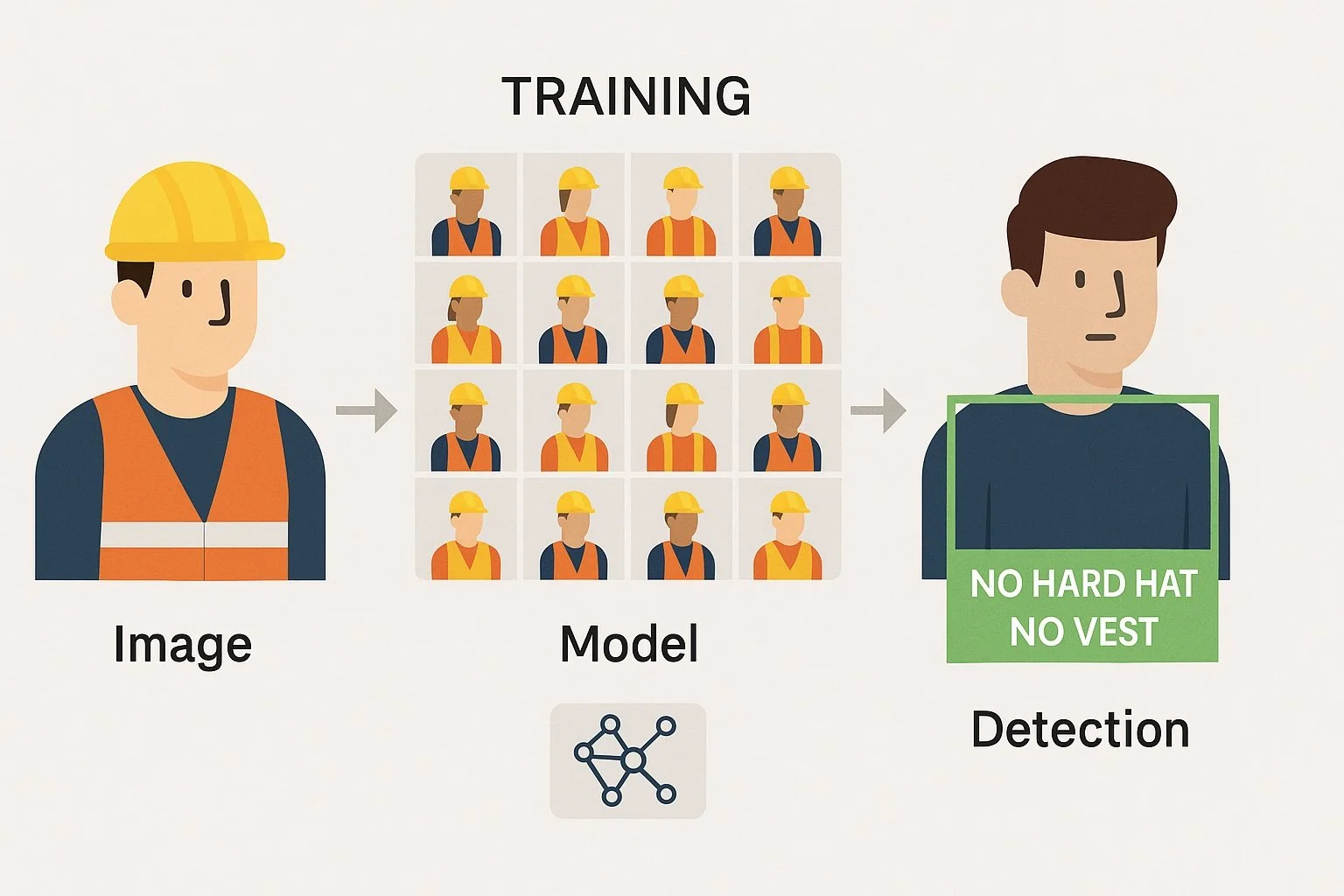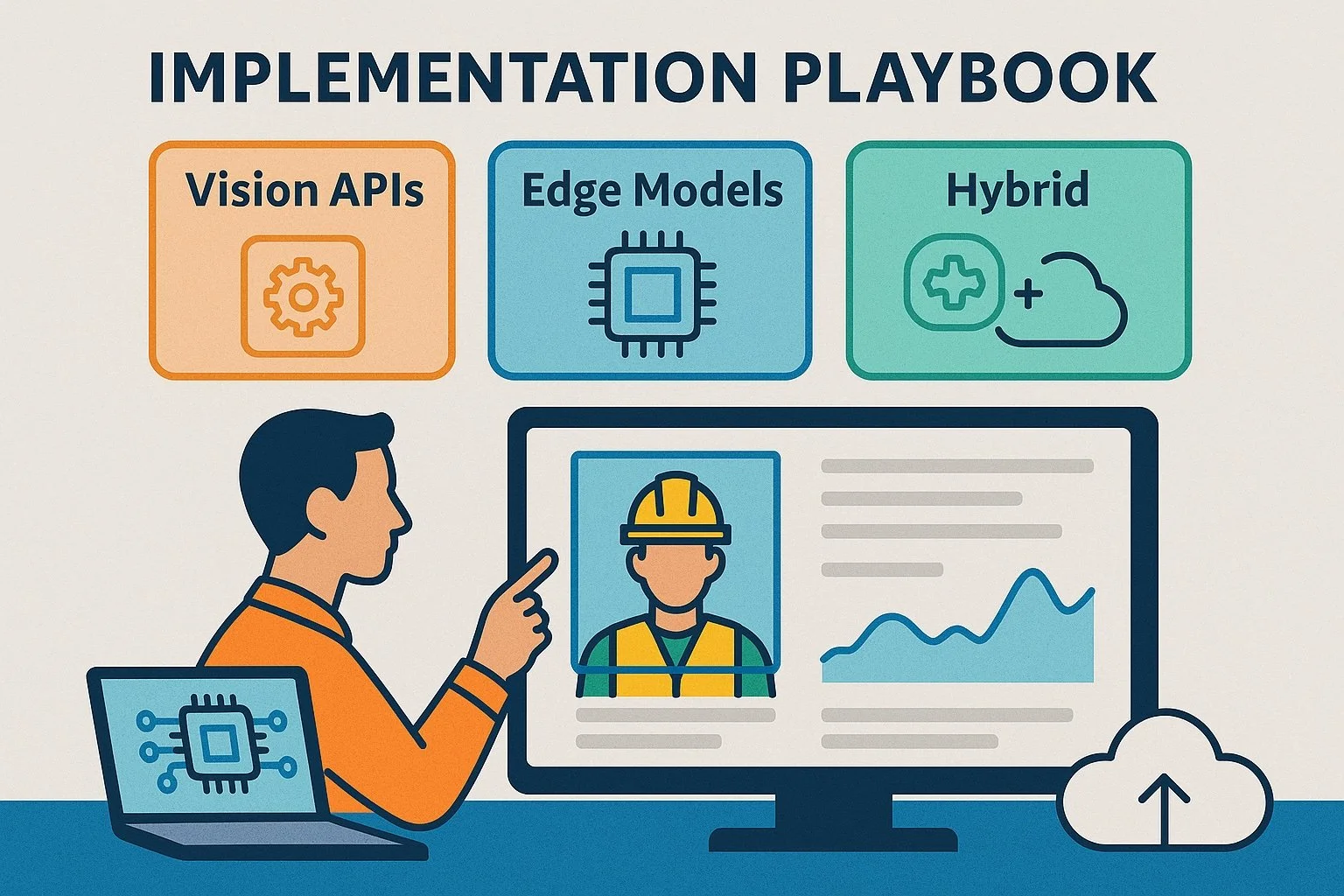Employee Safety Audits Powered by Smart Cameras
Introduction — Why “Always-On” Safety Has Finally Arrived
On construction sites, in factories, and across other high-risk work environments, personal protective equipment (PPE) like hard hats and high-visibility vests are critical. They’re not just required by law — they’re often the only line of defense between a worker and serious injury. But in real-world conditions, ensuring that every person on-site is properly geared up isn’t always easy. Human supervisors can’t be everywhere at once, and manual audits are time-consuming, inconsistent, and reactive.
That’s where smart cameras come in. Using artificial intelligence and computer vision, these cameras don’t just passively record — they actively monitor. They can detect whether workers are wearing the correct safety equipment in real time. If someone steps onto the job site without a helmet or removes their vest in a restricted area, the system can immediately alert supervisors. The result? Safer shifts, fewer accidents, and a major reduction in regulatory fines.
What makes this technology especially powerful is that it works silently in the background. Instead of overwhelming safety managers with constant footage or false alarms, these systems are trained to only react when something’s wrong. That means less time watching video and more time solving problems before they become serious.
The recent rise of cloud-based AI services and smarter edge devices has made this type of solution more accessible than ever. Companies no longer need to invest in building custom AI from scratch. With the right tools and setup, a basic camera feed can be transformed into a round-the-clock digital safety inspector — one that never sleeps, never gets distracted, and scales with your operations.
This post explores how smart camera-based safety audits work, what benefits they bring, and how AI-powered tools are changing the way businesses think about workplace safety.
The Hidden Costs of PPE Non-Compliance
At first glance, a missing hard hat or vest might seem like a small issue — something that can be corrected with a quick reminder. But in reality, lapses in personal protective equipment (PPE) compliance can have serious and costly consequences. These aren’t just safety concerns; they’re business risks.
Let’s start with the most visible cost: regulatory fines. Many countries have strict workplace safety rules. Agencies like OSHA (in the U.S.) and EU-OSHA (in Europe) can issue hefty penalties if workers are found without required safety gear. A single violation might cost thousands of dollars — and repeated offenses can lead to even higher fines, work stoppages, or legal action. For example, OSHA has fined companies over $100,000 in cases where basic PPE requirements weren’t enforced.
But the financial impact doesn’t stop with fines. Accidents caused by non-compliance can result in serious injuries or even fatalities. That means medical costs, insurance claims, legal settlements, and compensation payments. In many cases, insurance premiums also rise after a workplace incident, putting long-term pressure on a company’s operating budget.
Then there’s the cost of downtime. When an accident happens, work often stops. Investigations are launched, equipment may need repair, and timelines shift. In industries like construction or manufacturing, even a short delay can lead to missed deadlines and unhappy clients — both of which hurt the bottom line.
There are also hidden costs that don’t show up immediately on a balance sheet. Repeated safety failures can harm a company’s reputation, making it harder to attract skilled workers or win new contracts. Employee morale can suffer too. When workers don’t feel safe, productivity drops, and turnover rises.
That’s why many companies are starting to treat PPE compliance not just as a safety issue but as a strategic priority. By catching violations early — or better yet, preventing them altogether — businesses can avoid accidents, protect their teams, and save money.
Smart camera systems help make this possible. By using AI to monitor PPE usage automatically, they eliminate the need for constant manual checks and make it easier to spot problems before they escalate. And when fewer violations happen, the savings — in lives, time, and money — add up fast.
Computer Vision 101: Training Cameras to Spot Hard Hats & Vests
How can a camera tell if a worker is wearing a hard hat or a high-visibility vest? The answer lies in computer vision — a branch of artificial intelligence (AI) that teaches machines to understand and interpret visual information, just like humans do.
At the heart of this technology are object detection models. These models are trained to recognize specific items — like helmets, vests, gloves, or even people themselves — by learning patterns from thousands of images. During training, the AI is shown labeled examples of what a hard hat looks like from different angles, in different lighting, on different people. Over time, it learns to spot the object no matter the situation.
You might think that creating such a system would require collecting and labeling endless hours of footage from your specific site. But thanks to advancements in AI, that’s no longer the case. Many high-quality models have already been trained on diverse datasets, so they can recognize standard PPE in a wide range of environments right out of the box. For most use cases, these models can be used as-is or lightly fine-tuned with a small set of site-specific examples for even higher accuracy.
Once trained, the model is integrated into the camera system — either directly on the device (edge AI) or through a connection to the cloud. When the camera captures a frame, the AI analyzes it in real time to see if the necessary safety gear is present. If something is missing — for example, a person is visible but no helmet is detected — the system can flag it and send an alert.
It’s important to measure how well the model works. Key metrics include:
Precision: How often the model is right when it says something is missing.
Recall: How many actual violations the model is able to detect.
False positives: How often it raises an alert when everything is actually okay.
The goal is to strike the right balance — catching real issues while avoiding unnecessary noise.
For businesses looking to get started quickly, there are ready-to-use cloud APIs like API4AI’s Object Detection API or Image Labeling API, which can process images and return structured results (like “helmet: detected” or “vest: not found”) without the need for deep technical knowledge. These APIs can be plugged into camera systems, mobile apps, or safety dashboards, making it easier to test and deploy real-world solutions.
In short, computer vision gives cameras the power to "see" and understand the workplace — and with the right model behind them, they become reliable digital safety inspectors that never look away.
Edge-to-Cloud Pipeline: From Live Feed to Silent Alarm in <1 Second
Once a camera can recognize missing PPE, the next challenge is making sure that information reaches the right people at the right time. This is where a smart safety pipeline comes into play — a system that connects cameras, AI models, and alert systems to create a fast and efficient safety response. The goal is simple: detect an issue and notify someone instantly, without flooding teams with useless alerts.
Let’s break down how it works.
Step 1: Capturing the Video Feed
Everything starts with a video camera — usually one that’s already installed on-site. This can be a standard IP camera or a smart camera with built-in computing power. It continuously captures video footage of the area, such as an entrance to a construction zone or a busy factory floor.
Step 2: Running the Detection — Edge or Cloud?
Next, the video frames are analyzed using AI. This can happen in two ways:
Edge processing: The camera or a small device nearby (like a Raspberry Pi or an NVIDIA Jetson) runs the AI model locally. This means no need to send data over the internet, which makes it fast and good for remote areas or places with privacy concerns.
Cloud processing: The images or video frames are sent to a cloud server where the AI model runs. This allows access to more powerful models and makes updates easier, but requires stable internet and may have small delays (typically under 1 second).
Some systems use a hybrid approach, doing quick checks on the edge and sending only the flagged frames to the cloud for more detailed analysis.
Step 3: Triggering Alerts Only When Needed
If the AI detects a safety issue — like a missing helmet or vest — it sends a signal. This signal can be a webhook, push notification, email, or even a message in a team chat tool. The key is smart alerting:
Don’t alert for every frame — only when a violation persists (e.g. no helmet for 3 seconds).
Group multiple events into one alert to reduce noise.
Avoid false alarms by combining PPE detection with human detection (e.g., only alert if a person is present and not wearing required gear).
This helps supervisors stay focused. They’re alerted only when a real safety risk happens — not every time a worker walks past a camera.
Step 4: Integrating with Dashboards or Mobile Devices
Modern systems can connect alerts directly to safety dashboards, mobile apps, or even control room software. This way, supervisors don’t need to watch camera feeds all day. Instead, they can glance at a screen or receive a quick message on their phone when action is needed.
Some companies also record and store snapshots or short video clips of each violation, making it easy to review incidents or use them in safety training.
This entire process — from camera to detection to alert — can happen in under one second. With the right setup, it becomes a silent but powerful guardian of workplace safety, working around the clock with no need for breaks, and no risk of missing something important. Whether you’re managing one site or a hundred, this kind of smart pipeline makes it easy to stay on top of PPE compliance and take action the moment a problem appears.
From Video to KPI: Safety Dashboards Finance Teams Love
AI-powered cameras don’t just help in the moment — they also create valuable data that can be used to improve safety over time. Every time the system detects someone without proper PPE or spots a potential safety violation, it logs an event. These events become the foundation for powerful safety dashboards that offer insights for managers, safety officers, and even finance teams.
Turning Alerts into Useful Data
Each safety event detected by the system — like “no hard hat detected” or “high-vis vest missing” — is automatically saved with key details:
Timestamp (when it happened)
Location or camera ID (where it happened)
Type of violation (helmet, vest, etc.)
Snapshot or video clip (for review or training)
These individual events are stored in structured formats such as JSON, which makes it easy to feed them into analytics tools.
Visualizing Trends and Hotspots
Once the data is collected, it can be visualized on dashboards using tools like Tableau, Power BI, or custom web interfaces. This allows safety teams to quickly see:
Which areas have the most violations (e.g. Zone A is a hard-hat problem spot)
What times of day see the most safety issues
Which types of PPE are most frequently missed
Trends over time — are things getting better or worse?
These dashboards can also show PPE compliance rates across teams or departments, helping to identify where additional training may be needed.
Financial Impact and Cost Avoidance
What makes these dashboards especially powerful is their ability to show cost savings. By reducing violations and avoiding accidents, companies can:
Lower the risk of fines from safety regulators
Cut down on insurance claims and premiums
Minimize work stoppages or delays
Reduce legal costs related to workplace injuries
Some systems go a step further by estimating the financial value of safety improvements, showing leadership teams exactly how much money is being saved thanks to smarter monitoring.
Sharing Results Across the Business
Since the data is stored in standard formats and visualized through widely used tools, safety metrics can easily be shared across departments:
Operations teams use it to improve workflows
HR can use it to track safety performance for individuals or teams
Finance departments can plug the data into ROI reports and budget forecasts
Executives get a clear, top-down view of how safety contributes to business performance
In the past, safety audits meant clipboards and manual checklists. Today, smart cameras and AI turn raw video into meaningful KPIs that help teams stay safer — and smarter — at the same time. It’s no longer just about catching mistakes. It’s about measuring progress, driving accountability, and proving that better safety is better business.
Implementation Playbook: Choosing Vision APIs, Edge Models, or Hybrid
So, how do you actually set up a smart camera system that checks for hard hats and high-vis vests? There are different ways to build it, depending on your site’s needs, budget, and technical capabilities. This section walks through your main options — and what to consider before you begin.
Three Main Implementation Paths
Cloud-Based Vision APIs
This is the fastest and easiest way to get started.
Your camera sends image frames or short video clips to a cloud service.
The AI model runs on the cloud, detects safety gear, and returns the result.
No need to install or manage heavy software — you just use an API.
Ideal for: pilots, smaller sites, or companies without in-house AI teams.
✅ Pros: Fast setup, low maintenance, easy to scale
❌ Cons: Requires internet, some latency (~0.5–1 second), may raise privacy concerns
For example, ready-to-use tools like API4AI’s Object Detection API or Image Labeling API can instantly process camera snapshots and detect hard hats, vests, and even missing gear. These APIs return structured results that are easy to connect with dashboards or notification systems.
On-Premise Edge Models
In this setup, the AI runs locally on a device near the camera.
No internet connection is needed to run the model.
You can use small edge computers like NVIDIA Jetson Nano or similar.
Often used in remote locations or highly secure facilities.
Ideal for: areas with poor connectivity, strict data control, or real-time needs.
✅ Pros: Low latency, better data privacy, works offline
❌ Cons: Requires more technical setup, hardware costs, manual updates
Hybrid Architecture
A mix of both edge and cloud.
Quick detections (e.g., is a person present?) happen at the edge.
Complex tasks (e.g., identifying multiple PPE types) go to the cloud.
Reduces bandwidth use while maintaining accuracy.
Ideal for: larger sites with mixed requirements, future-proofing setup.
✅ Pros: Balanced performance and flexibility
❌ Cons: More complex to set up and manage
What You Need Before You Start
Here’s a basic checklist to prepare for a smart PPE audit system:
Cameras
Should provide clear images in typical site lighting.
Higher resolution helps improve detection accuracy.
Position cameras at entry points or key work areas.
Connectivity
For cloud APIs: stable internet connection.
For edge devices: local network or standalone setup.
Lighting Conditions
Good lighting improves model accuracy.
Consider IR or night-vision cameras for low-light sites.
Privacy & Compliance
Make sure your solution respects worker privacy.
Use tools like the API4AI Image Anonymization API to blur faces.
Follow local laws like GDPR when storing or processing video.
Customization Needs
Standard models work well for most safety gear.
If your PPE is custom-colored or branded, a fine-tuned model may help.
API4AI offers custom model training services to adapt to your unique setup — this can increase accuracy and reduce false alerts over time.
In summary, you don’t need a massive IT project to get started with AI-powered safety audits. Whether you go with cloud APIs, edge devices, or a hybrid mix, today’s tools make it possible to create a reliable, scalable system. And with the right planning, your smart camera setup can be tailored to match your operations perfectly — both now and as your needs grow.
Conclusion — Safer Shifts, Stronger Margins
Workplace safety has always been important — but now, thanks to AI and smart camera technology, it’s becoming smarter, faster, and more cost-effective. What used to rely on clipboards, manual patrols, and occasional checks can now happen automatically, 24/7, with cameras that recognize when protective gear is missing and alert the right people instantly.
This kind of system doesn’t just protect employees — it protects the business. Fewer accidents mean fewer delays, fewer fines, and lower insurance costs. It also builds trust with workers, clients, and regulators by showing that safety is a priority, not an afterthought.
The technology behind it is no longer limited to big corporations or massive budgets. With ready-to-use tools like cloud-based APIs (such as API4AI’s Object Detection, Image Anonymization, or Face Detection APIs) and edge computing devices, even small or mid-sized companies can start building a smarter safety system without hiring a team of AI engineers.
For businesses with unique gear, challenging environments, or more advanced needs, custom AI solutions can be developed and fine-tuned to deliver high accuracy and long-term value. These tailored setups may require a bit more planning, but they often lead to lower false positives, better worker experience, and more useful data.
Whether you’re just exploring the idea or ready to build a full solution, the path is clear: safety powered by smart cameras is here, and it’s already making a real impact. By starting now, you not only reduce risks — you gain a competitive edge in how you manage teams, sites, and operations.
Safer worksites aren’t just good for people — they’re good for business.






